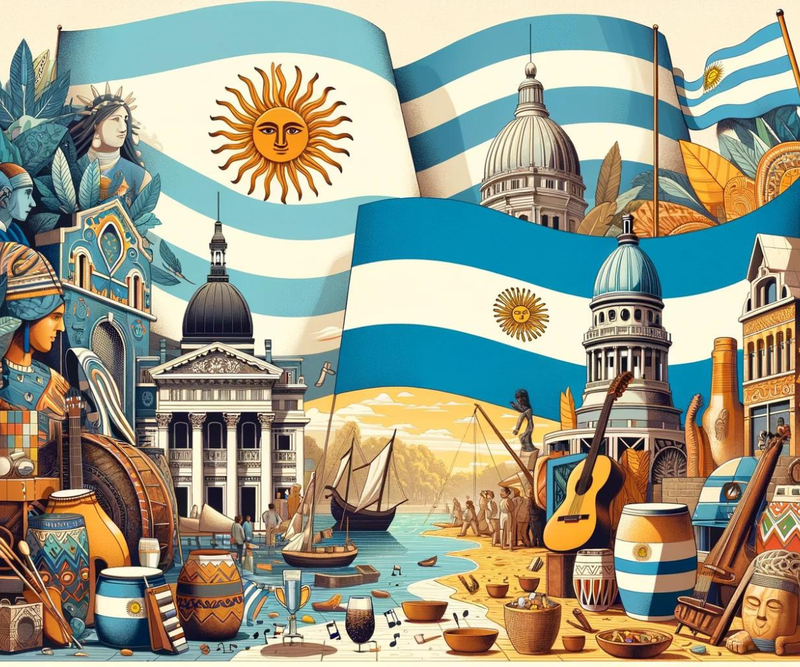During the last soccer or fútbol World Cup, an article in The Washington Post wondered why all the players in the Argentine team were white. This revived a debate about whether Argentina and its neighboring country, Uruguay, are nations with populations exclusively of European descent.
Although Argentina and Uruguay have historically been recipients of European immigration, the most recent studies state that it’s a mistake to consider them “white countries.” Why? Well, this implies denying their important indigenous and African roots that is in the population which have been crucial in shaping their societies.
Let’s explore what is “White Latin America” further. Is it a myth or a reality? What are the current influences of non-white populations?
Are Argentina and Uruguay white countries?
Argentina and Uruguay are two countries that share an important part of their culture. This originates from the fact that both nations were part of the same Spanish colony until the 19th century and since then they have shared very close political, social and cultural links. Even their accent is pretty much indistinguishable for a lot of people!
But let’s go back to our question: Are Argentina and Uruguay 100% white countries? Of course not! Although it’s estimated that close to 90% of the Argentine and Uruguayan population have at least one European ancestor, indigenous and African blood also runs through the population.
According to Roy Hora PhD, a professor at the University of San Andrés in Buenos Aires, Argentina the “whiteness” of these countries is anchored in two pillars: one, the great European immigration; and two, the idea of “cultural whitening” promoted from within the state government itself.
Factor 1: the wave of European immigration
Both Argentina and Uruguay (as well as other places, such as Cuba, Venezuela, Costa Rica, Colombia, Chile, Brazil, The Caribbean) have historically been colonized in waves of migration from Europe. However, the cases of Argentina and Uruguay were more significant.
Europeans went to the American continent running away from persecution from the Holocaust, civil wars, poverty, famine, and from WWI and WWII destruction and financial ruin. According to Carl Solberg’s "Peopling The Prairies And The Pampas; The Impact of Immigration on Argentine and Canadian Agrarian development," between 1881 and 1915, 4 million Europeans arrived at the port of Buenos Aires (Spanish and Italian, mostly), and more than 600,000 people arrived in Montevideo, Uruguay.
Factor 2: cultural whitening
The second factor that fuels the belief in a “white South America” has to do with an intention on the part of governments to sell that image. For example, from the beginning of the formation of Argentina as a nation, attempts have been made to establish that Argentina is a predominantly white and Europeanized country. In other words: they said “in Argentina there are no Indigenous or Blacks.”
During the last decades, the belief that there are no black people in Argentina grew bigger and bigger. Historians determined to build a national identity based on European heritage to benefit the country the state took it upon themselves to propagate the myth that “all black people were sent to the front lines of combat during armed conflicts,” such as the war against Paraguay. Although this is partially true, does that mean that there is a clear intention of hiding African history from the country?
Two hundred years ago, Buenos Aires was one of the largest slave ports on the entire continent. In fact, the 1778 census found that 46 percent of the Argentine population was of African origin. Currently, that number has decreased to 0.4 percent. In Uruguay, black population is currently closer to 10 percent. They share a common past of enslavement of their ancestors because of the slave trade during the colonial period in America.
The denial of the Afro and Indigenous past in these countries, mainly in Argentina, continues today. Actually, until a few years ago the perpetuated racism continued, the 100 peso bill had the face of former president Argentino Roca, one of the soldiers who carried out the Campaña del Desierto or Desert Campaign, in which thousands of indigenous people were massacred to steal their lands.
Another sign that this perception is very anchored in South-American cultures is recently the president of Argentina, Alberto Fernández said in a speech that “Argentines descend from ships, while Brazilians come from the jungle and Mexicans come from the Indians.” Although he tried to unsuccessfully quote a poet, his unfortunate statement caused controversy and a response from other regional leaders.
The Indigenous heritage of Argentina and Uruguay
All this leads to structural racism in Argentina and Uruguay which considers non-white people as “second-class citizens” due to Latin-America’s long and unfortunate history of La Casta or caste system presented by Europeans when first colonizing these countries. Unfortunately, we can see this just by turning on the TV while watching a novela, in the media with the lack of darker-skinned representation, in politics with those in power, and in the socio-economic spheres where white or white-passing people are clearly the majority.
However, recent research suggests that the history of Argentina and Uruguay are much more complex than previously thought. There is a strong indigenous heritage embedded in the DNA of these societies.
Research by Director of the Genetic Fingerprint Service of the School of Pharmacy and Biochemistry of the Universidad de Buenos Aires (UBA ) Daniel Corach, showed that “60% of Argentines have an indigenous background.” Another recent study shows that almost eight out of 10 people in Córdoba, the second largest and most populous city in Argentina after Buenos Aires, come from maternal Native American ancestors.
In South America, there are many indigenous populations that are currently fighting for greater recognition by the state such as the Guaraní, the Mapuche, and the Qom, just to name a few of the largest communities. In fact, according to Amnesty International, there are right now more that 200 conflicts over indigenous land as we speak.
Luckily, in the last decade, we have seen a lot of indigenous activism. For example, David Gudiño considers himself a “brown activist” (activista marrón in Spanish), and made a short film called La argentina no es blanca (“Argentina Is Not White”) to compete in the TikTok Short Films category at the Cannes Film Festival.
“Basically, we say that Argentina is not only white, that there are people with brown skin, with Indigenous features; that we inhabit this land and that we have a great presence,” says Gudiño.
Latin America is a diverse land
It’s important to note that African and Indigenous ancestry is measured by the determination of self-identification. This means that Latin Americans must push past the colorism that limits its inhabitants of the country to recognize themselves as such when filling out a government census. It’s very likely that many people may not know about their ancestry and who their ancestors were and that could explain the tendency to continue “Europeanizing” these countries.
We can’t deny that, between the 19th and the 20th centuries there was a huge wave of migration in Argentina, Uruguay and many other Latin American countries. However, looking only at this part of history implies continuing to promote racism. There is no doubt that Latin America and especially Argentina and Uruguay are diverse lands and the current African, Afrolatino and Indigenous activism is making it clear.






